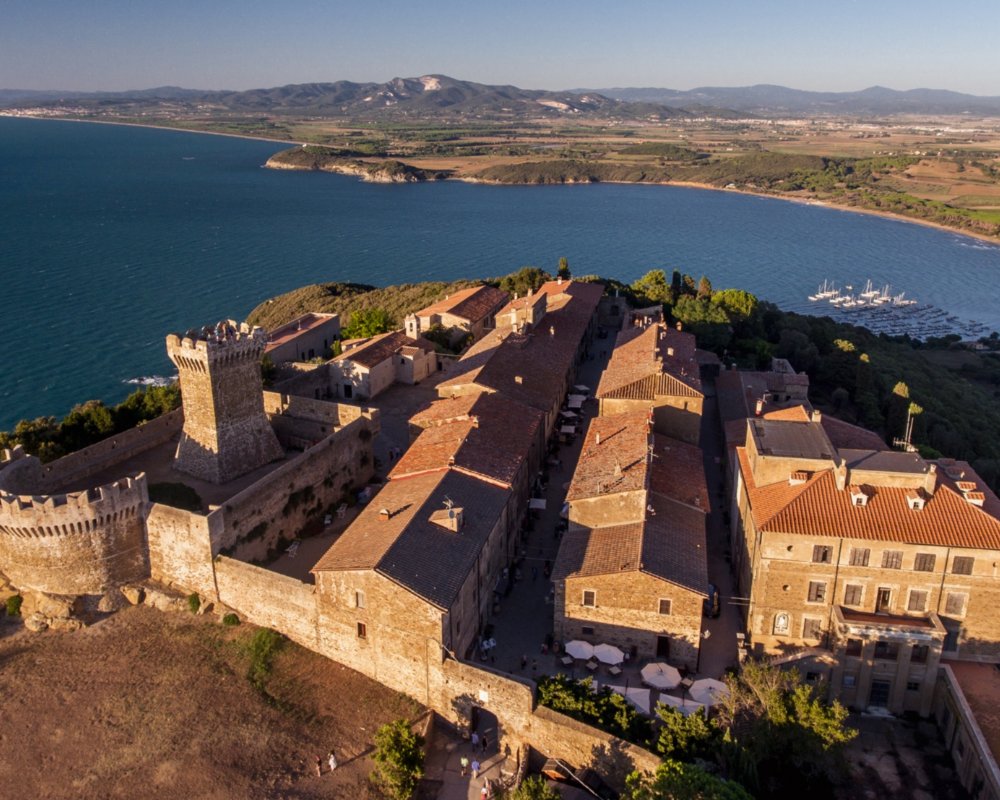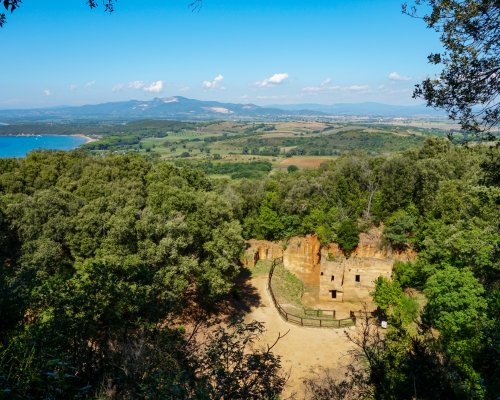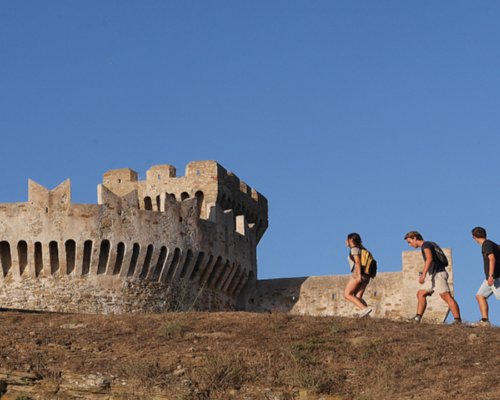Three days of archaeology, bays and parks in southern Tuscany
Traces of the ancient and mysterious Etruscan civilization can be found all throughout Tuscany, but nowhere are they better seen than on the Etruscan Coast, running from Castiglioncello all the way down to Piombino. Here, you can find millennia-old tombs, archaeology museums and parks and kilometres of gorgeous shoreline.
If you’re looking for a holiday off the beaten track, following in the footsteps of these powerful and enigmatic peoples, check out our tips for three days of history and nature.
Start your journey at the Northern promontory of the Etruscan Coast, basing yourself in the historical port city of Piombino, home to some of the most impressive Etruscan ruins in this area and the ideal starting point from which to explore the Etruscan Coast.
Delve into the heart of Etruscan history and culture with a visit to Populonia Alta, an ancient Etruscan mining town which is easily accessible from Piombino. Perched high above the Gulf of Baratti, Populonia Alta was the first and only coastal village built by the Etruscans, and today houses an impressive Acropolis as well as The Gasparri Etruscan museum, a private museum containing Etruscan and Roman artefacts found in the surrounding area.
Take the panoramic road that leads to the Gulf of Baratti to find the real reason for visiting and immerse yourself in the fascinating 80-acre Archaeological Park. The park combines a breath-taking Mediterranean landscape with a number of Etruscan and Roman tombs and artefacts, and can be explored through various designated routes that provide a fascinating glimpse into the evolution of the scenery over the centuries, the San Cerbone monumental necropolis, the only one built near the sea and the Necropolis “delle Grotte” (4th century BCE).
From Populonia, you can reach the beautiful rocky bay of Buca delle Fate, nestled between the promontories of Populonia and Piombino. Buca delle Fate can be reached by driving along the via dei Cavalleggeri, the route often used by the Grand Dukes of Tuscany to watch over the Piombino promontory, or for those who really want to get in amongst nature, there is a simple and picturesque 3.5 kilometre walk following the walking route ‘Il Senitero 301” that leads to the bay and passes by a variety of Mediterranean vegetation and Etruscan tombs. The bay itself is a small corner of paradise where vegetation and rocks meet a crystal clear sea. Spread a towel over one of the large flat rocks and enjoy the sunshine and panoramic view of the horizon.
Head back to Piombino after a busy day of sightseeing and sunbathing to end the day with a walk through the historic town centre and a dinner which includes some local culinary delights of the port-side town, such as baccalà and potatoes, the fish stew cacciucco, cuttlefish and stewed or stuffed mussels.
Start your journey at the Northern promontory of the Etruscan Coast, basing yourself in the historical port city of Piombino, home to some of the most impressive Etruscan ruins in this area and the ideal starting point from which to explore the Etruscan Coast.
Delve into the heart of Etruscan history and culture with a visit to Populonia Alta, an ancient Etruscan mining town which is easily accessible from Piombino. Perched high above the Gulf of Baratti, Populonia Alta was the first and only coastal village built by the Etruscans, and today houses an impressive Acropolis as well as The Gasparri Etruscan museum, a private museum containing Etruscan and Roman artefacts found in the surrounding area.
Take the panoramic road that leads to the Gulf of Baratti to find the real reason for visiting and immerse yourself in the fascinating 80-acre Archaeological Park. The park combines a breath-taking Mediterranean landscape with a number of Etruscan and Roman tombs and artefacts, and can be explored through various designated routes that provide a fascinating glimpse into the evolution of the scenery over the centuries, the San Cerbone monumental necropolis, the only one built near the sea and the Necropolis “delle Grotte” (4th century BCE).
From Populonia, you can reach the beautiful rocky bay of Buca delle Fate, nestled between the promontories of Populonia and Piombino. Buca delle Fate can be reached by driving along the via dei Cavalleggeri, the route often used by the Grand Dukes of Tuscany to watch over the Piombino promontory, or for those who really want to get in amongst nature, there is a simple and picturesque 3.5 kilometre walk following the walking route ‘Il Senitero 301” that leads to the bay and passes by a variety of Mediterranean vegetation and Etruscan tombs. The bay itself is a small corner of paradise where vegetation and rocks meet a crystal clear sea. Spread a towel over one of the large flat rocks and enjoy the sunshine and panoramic view of the horizon.
Head back to Piombino after a busy day of sightseeing and sunbathing to end the day with a walk through the historic town centre and a dinner which includes some local culinary delights of the port-side town, such as baccalà and potatoes, the fish stew cacciucco, cuttlefish and stewed or stuffed mussels.
After breakfast in Piombino, drive along the panoramic Via Aurelia towards San Vincenzo, which combines natural beauty and history. Its stunning beach, recognised for many years as a European Union Blue Flag Beach, provides the perfect stop for a stroll or a swim. Not to be missed is the Rimigliano Nature Park, one of the most breath-taking of the Val di Cornia parks, which includes a variety of thick pine wood, holm oak and fir trees as well as dunes covered in Mediterranean shrub and many small woodland animals that inhabit this park.
For those interested in finding out more about this area’s mining heritage, a little further inland you can find the Archaeological Mining Park of San Silvestro, to learn more about the processes and importance of the mining of metals from the Island of Elba.
San Vincenzo and its surroundings make up part of the renowned Etruscan Coast Wine Road, considered one of the best wine production sites in Tuscany. In the afternoon, take a turn slightly inland into the heart of Tuscan wine country, to discover the municipality of Castagneto Carducci. Sassicaia, Ornellaia and Masseto are amongst the extraordinary wineries located here, and the surrounding countryside is perfect for discovering some of the finest Tuscan wines on offer.
Drive to the hamlet of Bolgheri through the spectacular Viale dei Cipressi, boasting a genuine picture-perfect vision of Tuscany. Viale dei Cipressi is a long, straight road with rows of dense, centuries-old cypress trees on both sides – 2,540 in total - which was built in the 19th century and famously mentioned by the Italian poet and former resident of the area, Giosuè Carducci in his poem “Davanti San Guido”.
You can’t take cars into the village of Bolgheri but you can park at one of the car parks at the entrance to the main gate and explore this beautiful medieval hamlet on foot. At the entrance of the village there is a red-brick castle. Inside, the alleys are paved, the ancient stone buildings adorned with geraniums; there are craft shops, wine bars, taverns and restaurants offering typical products and wines.
Spend the night here or, for an experience that brings you closer to nature, in one of the many high quality agritourisms in this area.
After breakfast in Piombino, drive along the panoramic Via Aurelia towards San Vincenzo, which combines natural beauty and history. Its stunning beach, recognised for many years as a European Union Blue Flag Beach, provides the perfect stop for a stroll or a swim. Not to be missed is the Rimigliano Nature Park, one of the most breath-taking of the Val di Cornia parks, which includes a variety of thick pine wood, holm oak and fir trees as well as dunes covered in Mediterranean shrub and many small woodland animals that inhabit this park.
For those interested in finding out more about this area’s mining heritage, a little further inland you can find the Archaeological Mining Park of San Silvestro, to learn more about the processes and importance of the mining of metals from the Island of Elba.
San Vincenzo and its surroundings make up part of the renowned Etruscan Coast Wine Road, considered one of the best wine production sites in Tuscany. In the afternoon, take a turn slightly inland into the heart of Tuscan wine country, to discover the municipality of Castagneto Carducci. Sassicaia, Ornellaia and Masseto are amongst the extraordinary wineries located here, and the surrounding countryside is perfect for discovering some of the finest Tuscan wines on offer.
Drive to the hamlet of Bolgheri through the spectacular Viale dei Cipressi, boasting a genuine picture-perfect vision of Tuscany. Viale dei Cipressi is a long, straight road with rows of dense, centuries-old cypress trees on both sides – 2,540 in total - which was built in the 19th century and famously mentioned by the Italian poet and former resident of the area, Giosuè Carducci in his poem “Davanti San Guido”.
You can’t take cars into the village of Bolgheri but you can park at one of the car parks at the entrance to the main gate and explore this beautiful medieval hamlet on foot. At the entrance of the village there is a red-brick castle. Inside, the alleys are paved, the ancient stone buildings adorned with geraniums; there are craft shops, wine bars, taverns and restaurants offering typical products and wines.
Spend the night here or, for an experience that brings you closer to nature, in one of the many high quality agritourisms in this area.
After breakfast in Bolgheri, set off for the delightful medieval town of Bibbona, which dates to the Villanovan era and was later inhabited by the Etruscans. The town centre is made of small winding medieval streets and piazzas, and a stand-out stop is the Renaissance Church of Santa Maria della Pietà, which houses some exquisite 17th-century marble ornaments and a beautiful 14th-century Pietà.
Continue to the popular Marina di Bibbona, where the long sandy beaches and enchanting pine forest provide the perfect place to unwind in beautiful surroundings. For true nature aficionados, the Macchia della Magona, a magical, protected woodland area, is a must-see. It boasts 17 different itineraries for lovers of hiking, horse-riding or cycling, surrounded by lush Tuscan vegetation and a huge variety of tree and animal species. If cycling in these breath-taking surroundings takes your fancy, there are some fantastic routes through the hills or along the coast, such as the Gran Fondo Costa degli Etruschi.
The town of Cecina is nestled between the rolling Tuscan countryside and the Etruscan coast, and has a dense pinewood bordering 15 kilometres of beach, which also provides the perfect location for a spot of walking or cycling. Combine an outdoor excursion with a trip to the Guerrazzi Museum to get your fill of Etruscan and Roman artefacts and to the Roman settlement of Villa di San Vincenzino, which was excavated in the 1960s and 80s and provides an interesting insight into Roman civilisation in this area. Good food is also important in this area and there are a number of cultural events that take place here during the year.
As the sun begins to set, make your way to the Rosignano Marittimo area, and the old Etruscan town of Castiglioncello. Set upon a sweeping bay, Castiglioncello has inspired generations of artists and boasts a thriving cultural scene, as well as an awe-inspiring stretch of coastline. There are a variety of accommodation options here and a number of restaurants where you can enjoy a fresh catch of the day. It is also home to the National Archaeological Museum, an important archaeological area discovered in the first decade of the 20th century.
The Etruscans left important traces in the Rosignano Marittimo area, as seen in the burial grounds unearthed in Castiglioncello, Rosignano Solvay, Vada and Castelnuovo della Misericordia. Castiglionello and the nearby bays of Chieco and Rosignano Solvay also provide an array of water sports opportunities and diving for those who want to get closer to rich seabeds along this stretch of coastline.
After breakfast in Bolgheri, set off for the delightful medieval town of Bibbona, which dates to the Villanovan era and was later inhabited by the Etruscans. The town centre is made of small winding medieval streets and piazzas, and a stand-out stop is the Renaissance Church of Santa Maria della Pietà, which houses some exquisite 17th-century marble ornaments and a beautiful 14th-century Pietà.
Continue to the popular Marina di Bibbona, where the long sandy beaches and enchanting pine forest provide the perfect place to unwind in beautiful surroundings. For true nature aficionados, the Macchia della Magona, a magical, protected woodland area, is a must-see. It boasts 17 different itineraries for lovers of hiking, horse-riding or cycling, surrounded by lush Tuscan vegetation and a huge variety of tree and animal species. If cycling in these breath-taking surroundings takes your fancy, there are some fantastic routes through the hills or along the coast, such as the Gran Fondo Costa degli Etruschi.
The town of Cecina is nestled between the rolling Tuscan countryside and the Etruscan coast, and has a dense pinewood bordering 15 kilometres of beach, which also provides the perfect location for a spot of walking or cycling. Combine an outdoor excursion with a trip to the Guerrazzi Museum to get your fill of Etruscan and Roman artefacts and to the Roman settlement of Villa di San Vincenzino, which was excavated in the 1960s and 80s and provides an interesting insight into Roman civilisation in this area. Good food is also important in this area and there are a number of cultural events that take place here during the year.
As the sun begins to set, make your way to the Rosignano Marittimo area, and the old Etruscan town of Castiglioncello. Set upon a sweeping bay, Castiglioncello has inspired generations of artists and boasts a thriving cultural scene, as well as an awe-inspiring stretch of coastline. There are a variety of accommodation options here and a number of restaurants where you can enjoy a fresh catch of the day. It is also home to the National Archaeological Museum, an important archaeological area discovered in the first decade of the 20th century.
The Etruscans left important traces in the Rosignano Marittimo area, as seen in the burial grounds unearthed in Castiglioncello, Rosignano Solvay, Vada and Castelnuovo della Misericordia. Castiglionello and the nearby bays of Chieco and Rosignano Solvay also provide an array of water sports opportunities and diving for those who want to get closer to rich seabeds along this stretch of coastline.


